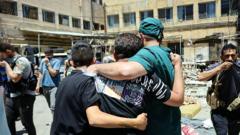What Happened During the Bloodbath in Suweida? Insights from Druze Residents

Understanding the Current Crisis in Suweida: A Comprehensive Overview
In recent days, the southern Syrian city of Suweida has become a focal point of violence, chaos, and fear. Residents, particularly from the Druze community, have described scenes of terror and bloodshed that they never expected to witness in their once-peaceful hometown. Rima, a 45-year-old Druze woman, shared her harrowing experiences as gunmen roamed her neighborhood, creating an atmosphere of anxiety and despair. This article delves into the complexities of the ongoing conflict, examining the factors that have led to such unprecedented violence and the implications for the local population.
The Prelude to Violence: Historical Context
Suweida, known for its Druze majority, has historically been a relatively stable region amidst the broader chaos of the Syrian civil war. However, long-standing tensions between the Druze and Bedouin tribes have simmered beneath the surface. These tensions erupted dramatically following the abduction of a Druze merchant on a key highway to the capital, Damascus. This incident acted as a catalyst, triggering violent clashes that have since escalated into a full-blown crisis.
The Druze community, which has maintained a distinct identity and autonomy within Syria, has often found itself at odds with various factions vying for control. The conflict in Suweida reflects not only local grievances but also broader national issues related to governance, security, and sectarianism.
Eyewitness Accounts: A Glimpse into the Horror
Eyewitness testimonies from residents like Rima and Nayef provide chilling insights into the current state of affairs in Suweida. Rima describes witnessing bodies littering the streets, a stark contrast to the life she once knew. As she huddled in her home, the fear of government forces and foreign fighters invading her neighborhood became a grim reality. This sentiment is echoed by Nayef, who recounted the gruesome task of collecting bodies from the streets, emphasizing the brutality of government troops targeting both Druze fighters and civilians.
The Role of Government Forces and Foreign Fighters
The deployment of government forces ostensibly aimed to restore order but instead exacerbated the violence. Reports indicate that these troops have been involved in acts of brutality, including looting and indiscriminate killings. The situation worsened with the involvement of foreign fighters, complicating an already volatile environment. This has left the residents of Suweida feeling isolated, vulnerable, and betrayed by those meant to protect them.
International Response: The Strikes from Israel
In response to the escalating violence, the Israeli military intervened with airstrikes, claiming they were acting to protect the Druze community. This intervention has sparked a complex debate among residents about loyalty and patriotism. While some view Israel's actions as a necessary measure for their safety, others express deep-seated resentment, emphasizing their desire for national sovereignty and the right to self-defense without external intervention.
The Human Cost of Conflict
The Syrian Observatory for Human Rights has reported staggering statistics: at least 594 individuals have been killed since the onset of violence, including a significant number of Druze civilians. This number includes those who faced summary executions, highlighting the grim reality faced by the people of Suweida. The brutal nature of these killings reflects a breakdown of trust between the community and the government forces, as many believe these acts are a betrayal rather than a safeguard.
Social Media as a Double-Edged Sword
In the age of technology, social media has played a dual role in this conflict. While it has served as a platform for residents to document and share their experiences, it has also been a tool for spreading propaganda and exacerbating fears. Videos of violence and humiliation have circulated widely, showcasing the brutality faced by residents and providing a stark visual representation of their suffering. This has led to increased anxiety within the community, further complicating the already dire situation.
The Government's Promises: A Skeptical Reception
In a televised address, interim President Ahmed al-Sharaa vowed to hold accountable those responsible for the violence against the Druze. However, many residents remain skeptical of these promises. Historical precedents have shown that government assurances often fail to translate into meaningful action. The lack of trust in the government's ability to protect its citizens continues to loom large over the community, fostering an environment of hopelessness.
Long-Term Implications of Sectarian Violence
The enduring impact of this recent eruption of violence is expected to reshape the socio-political landscape of Suweida. Many residents fear that the sectarian violence may lead to a lasting rift within the community, significantly altering relationships among different ethnic and religious groups. The scars of trauma and loss may take years to heal, leaving a generation marked by conflict.
The Path Forward: Seeking Stability in Chaos
As the situation in Suweida evolves, the path towards stability remains uncertain. The interplay of local grievances, government actions, and external influences will continue to shape the future of the region. Community leaders and residents alike must navigate a complex web of alliances, fears, and aspirations as they strive for peace amidst chaos.
Conclusion: A Call for Awareness and Action
The crisis in Suweida serves as a reminder of the fragility of peace and the human cost of conflict. As residents like Rima and Nayef endure unimaginable hardships, the international community must remain vigilant and responsive to their plight. Awareness is the first step towards fostering understanding, compassion, and ultimately, change. How can we, as global citizens, contribute to bringing peace and stability to conflict-ridden regions like Suweida? The answer lies in solidarity, empathy, and a commitment to advocating for human rights.
FAQs
What sparked the recent violence in Suweida?
The violence was triggered by the abduction of a Druze merchant, leading to escalated tensions between the Druze community and Bedouin tribes, compounded by the involvement of government forces.
How many casualties have been reported in the recent clashes?
According to reports, at least 594 individuals have been killed in the recent violence, including numerous Druze civilians.
What role has the Israeli military played in the conflict?
The Israeli military intervened with airstrikes, claiming to protect the Druze community from the violence perpetrated by government forces and foreign fighters.
In the face of such turmoil, how can we ensure that the voices of the affected communities are not silenced? #Suweida #HumanRights #SyrianConflict
Published: 2025-07-18 12:42:08 | Category: technology



